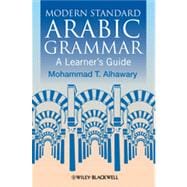
The Aim of this Book.
Why Learn/Teach Grammar?
Is the Arabic Language Difficult to Learn?
The Organization and Content of the Book.
Background Knowledge Required of the Reader.
Transliteration Symbols of Arabic Sounds.
Abbreviations.
1 Arabic Script and Sounds.
1.1 Arabic Script: The Alphabet.
1.2 Arabic Sounds.
1.3 Gemination.
1.4 Stress.
1.5 Spelling Variations of 'alif.
1.6 taa' marbuuTa.
1.7 Definiteness.
1.8 Formal MSA vs. Informal MSA.
1.9 Helping Vowels and Dropping the hamza of the Definite Article.
1.10 Dropping the hamza and 'alif Seat of the Definite Article in Writing.
1.11 Summary.
2 Word Structure.
2.1 The Basic Components of the Arabic Word: Root and Pattern.
2.2 Gender.
2.3 Number.
2.4 Summary.
3 Noun Phrase Structure.
3.1 Noun–adjective Phrase.
3.2 Demonstrative Phrase.
3.3 ’iDaafa Phrase.
3.4 Adjective 'iDaafa Phrase.
3.5 Summary.
4 Sentence Structure.
4.1 The Verbal Sentence.
4.2 The Nominal Sentence.
4.3 Summary.
5 Pronouns.
5.1 Personal Pronouns.
5.2 Object Pronouns.
5.3 Possessive Pronouns.
5.4 Demonstrative Pronouns.
5.5 Relative Pronouns and the Definite Relative Clause.
5.6 Dropping of Relative Pronouns and the Indefinite Relative Clause.
5.7 The Particles and man Functioning as Relative Pronouns.
5.8 Sound Changes to Pronoun and Word Endings.
5.9 Summary.
6 Prepositions.
6.1 Basic meanings and Use of Prepositions.
6.2 Idiomatic Usage and Expressions Involving Prepositions.
6.3 Occurrence with Pronoun Suffixes and Resulting Sound Changes.
6.4 Summary.
7 Question Words and Question Formation.
7.1 Question Formation and Question Words.
7.2 Summary.
8 Adverbs of Time and Place.
8.1 Adverbs of Time.
8.2 Adverbs of Place.
8.3 Words Used as Adverbs of Time or Place.
8.4 Dropping of Adverbs while Retaining Adverbial Meaning.
8.5 Occurrence of Adverbs of Time and Place with Prepositions.
8.6 Expressing Adverbial Meanings by a Preposition Followed by a Noun.
8.7 Other Uses of Adverbs.
8.8 Summary.
9 Adverbs of Manner.
9.1 Adverbs of Manner Occurring as a Single Word.
9.2 Adverbs of Manner Occurring as Non-derived Nouns.
9.3 Adverbs of Manner Occurring as a Phrase.
9.4 Adverbs of Manner Occurring as a Verbal Sentence.
9.5 Adverbs of Manner Occurring as a Nominal Sentence.
9.6 Dropping of Adverbs of Manner with Prepositional and Adverbial Phrases.
9.7 Summary.
10 Adverbs of Specification.
10.1 Adverbs of Specification Clarifying an Ambiguous Word.
10.2 Adverbs of Specification Clarifying an Ambiguous Verb.
10.3 Adverbs of Specification Clarifying an Ambiguous (Nominal) Sentence.
10.4 Summary.
11 Adverbs of Cause.
11.1 Adverbs of Cause Occurring as Indefinite Singular Verbal Noun/Gerund.
11.2 Adverbs of Cause Occurring as an ’iDaafa Phrase.
11.3 Other Ways of Expressing Adverbs of Cause.
11.4 Summary.
12 Adverbs of Emphasis/Cognate Accusative.
12.1 Adverbs of Emphasis Emphasizing a Verb/Action or a Word in a Sentence.
12.2 Other Uses of Adverbs of Emphasis.
12.3 Adverbs of Emphasis Emphasizing a Sentence.
12.4 Adverbs of Emphasis Occurring as an’iDaafa Phrase.
12.5 Dropping Adverbs of Emphasis
12.6 Summary.
13 The Verb.
13.1 Common Triliteral Verb Forms.
13.2 Meanings of the Common Triliteral Verb Forms.
13.3 Common Quadriliteral Verb Forms.
13.4 Categories of Arabic Verbs and Conjugations.
13.5 The Imperative.
13.6 The Negative Imperative.
13.7 The Passive Voice.
13.8 Summary.
14 The Noun.
14.1 The Non-derived Noun.
14.2 The Verbal Noun.
14.3 The Active Participle.
14.4 The Passive Participle.
14.5 Nouns of Time and Place.
14.6 Nouns of Instrument.
14.7 Nouns of Once.
14.8 Derived Abstract Nouns.
14.9 The Diminutive Noun.
14.10 The Five Nouns.
14.11 Summary.
15 The Adjective.
15.1 Main Adjective Patterns.
15.2 Color and Bodily Defect/Beauty Adjective Patterns.
15.3 Adjective Use.
15.4 The Comparative and Superlative.
15.5 The Active Participle.
15.6 The Passive Participle.
15.7 The Relative/nisba Adjective.
15.8 Summary.
16 Quantifiers and Emphasis.
16.1 Quantifiers.
16.2 Emphasis Words.
16.3 Other Ways of Expressing Emphasis.
16.4 Summary.
17 Conditional Sentences.
17.1 The Possible/Probable Conditional Sentence.
17.2 The Improbable Conditional Sentence.
17.3 The Impossible Conditional Sentence.
17.4 Summary.
18 Exceptive Sentences.
18.1 Exceptive Words and Their Use.
18.3 The Structure of "Especially".
18.4 Summary.
19 The Vocative.
19.1 The Vocative Particle.
19.2 Dropping the Vocative Particle.
19.3 Optative Use of the Vocative Particle.
19.4 Derogatory Use of the Vocative Particle.
19.5 The Vocative Particles.
19.6 Summary.
20 Exclamation.
20.1 Two Regular Expressions.
20.2 Use of the Vocative Particle ?? and the Exclamation Particle.
20.3 Use of Certain Question Words and Phrases.
20.4 Summary.
21 Apposition.
21.1 Types of Apposition Nouns.
21.2 Definiteness Agreement within Noun–Noun Apposition.
21.3 Use of "Son" and the Noun Following it as an Apposition Noun.
21.4 Summary.
22 Triptote, Diptote, and Indeclinable/Invariable.
22.1 The Indeclinable/Invariable.
22.2 The Declinable.
22.3 Summary.
References and Further Reading (in Arabic).
Appendix A The Geometric Basis of Arabic Numerals.
Appendix B The Writing of the hamza.
Appendix C The Phoenician Alphabet.
Appendix D Identifying the Root and Looking up Words in the Dictionary.
Appendix E The Number Phrase.
English Index.
Arabic Index.
The New copy of this book will include any supplemental materials advertised. Please check the title of the book to determine if it should include any access cards, study guides, lab manuals, CDs, etc.
The Used, Rental and eBook copies of this book are not guaranteed to include any supplemental materials. Typically, only the book itself is included. This is true even if the title states it includes any access cards, study guides, lab manuals, CDs, etc.